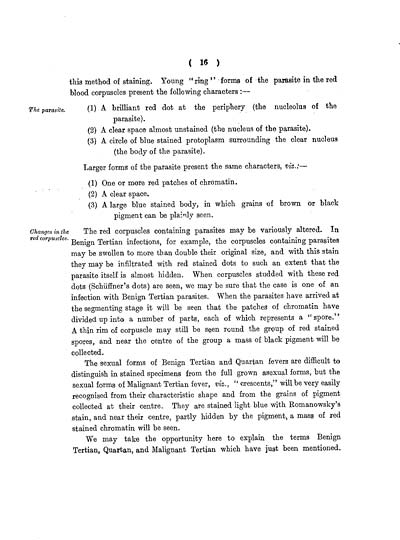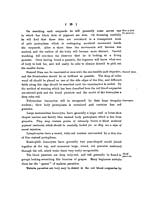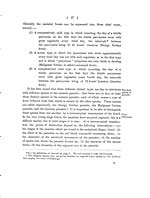Medicine - Disease > Malarial fevers
(22) Page 16
Download files
Individual page:
Thumbnail gallery: Grid view | List view

(16)
this method of staining. Young "ring" forms of the parasite in the red
blood corpuscles present the following characters:-
The parasite.
(1) A brilliant red dot at the periphery (the nucleolus of the
parasite).
(2) A clear space almost unstained (the nucleus of the parasite).
(3) A circle of blue stained protoplasm surrounding the clear nucleus
(the body of the parasite).
Larger forms of the parasite present the same characters, viz.:-
(1) One or more red patches of chromatin.
(2) A clear space.
(3) A large blue stained body, in which grains of brown or black
pigment can be plainly seen.
Changes in the
red corpuscles.
The red corpuscles containing parasites may be variously altered. In
Benign Tertian infections, for example, the corpuscles containing parasites
may be swollen to more than double their original size, and with this stain
they may be infiltrated with red stained dots to such an extent that the
parasite itself is almost hidden. When corpuscles studded with these red
dots (Schffner's dots) are seen, we may be sure that the case is one of an
infection with Benign Tertian parasites. When the parasites have arrived at
the segmenting stage it will be seen that the patches of chromatin have
divided up into a number of parts, each of which represents a "spore."
A thin rim of corpuscle may still be seen round the group of red stained
spores, and near the centre of the group a mass of black pigment will be
collected.
The sexual forms of Benign Tertian and Quartan fevers are difficult to
distinguish in stained specimens from the full grown asexual forms, but the
sexual forms of Malignant Tertian fever, viz., "crescents," will be very easily
recognised from their characteristic shape and from the grains of pigment
collected at their centre. They are stained light blue with Romanowsky's
stain, and near their centre, partly hidden by the pigment, a mass of red
stained chromatin will be seen.
We may take the opportunity here to explain the terms Benign
Tertian, Quartan, and Malignant Tertian which have just been mentioned.
this method of staining. Young "ring" forms of the parasite in the red
blood corpuscles present the following characters:-
The parasite.
(1) A brilliant red dot at the periphery (the nucleolus of the
parasite).
(2) A clear space almost unstained (the nucleus of the parasite).
(3) A circle of blue stained protoplasm surrounding the clear nucleus
(the body of the parasite).
Larger forms of the parasite present the same characters, viz.:-
(1) One or more red patches of chromatin.
(2) A clear space.
(3) A large blue stained body, in which grains of brown or black
pigment can be plainly seen.
Changes in the
red corpuscles.
The red corpuscles containing parasites may be variously altered. In
Benign Tertian infections, for example, the corpuscles containing parasites
may be swollen to more than double their original size, and with this stain
they may be infiltrated with red stained dots to such an extent that the
parasite itself is almost hidden. When corpuscles studded with these red
dots (Schffner's dots) are seen, we may be sure that the case is one of an
infection with Benign Tertian parasites. When the parasites have arrived at
the segmenting stage it will be seen that the patches of chromatin have
divided up into a number of parts, each of which represents a "spore."
A thin rim of corpuscle may still be seen round the group of red stained
spores, and near the centre of the group a mass of black pigment will be
collected.
The sexual forms of Benign Tertian and Quartan fevers are difficult to
distinguish in stained specimens from the full grown asexual forms, but the
sexual forms of Malignant Tertian fever, viz., "crescents," will be very easily
recognised from their characteristic shape and from the grains of pigment
collected at their centre. They are stained light blue with Romanowsky's
stain, and near their centre, partly hidden by the pigment, a mass of red
stained chromatin will be seen.
We may take the opportunity here to explain the terms Benign
Tertian, Quartan, and Malignant Tertian which have just been mentioned.
Set display mode to: Large image | Zoom image | Transcription
Images and transcriptions on this page, including medium image downloads, may be used under the Creative Commons Attribution 4.0 International Licence unless otherwise stated. ![]()
| India Papers > Medicine - Disease > Malarial fevers > (22) Page 16 |
|---|
| Permanent URL | https://digital.nls.uk/74558894 |
|---|




